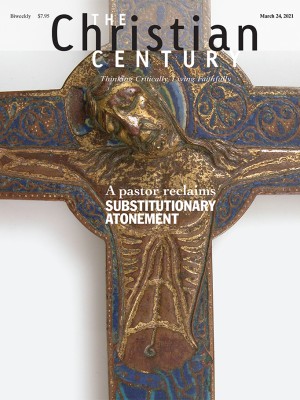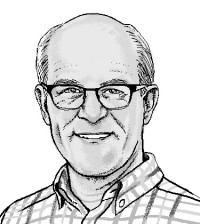April 11, Easter 2B (Acts 4:32-35; John 20:19-31)
Thomas gets so overwhelmed by Jesus’ presence that he ends up shelving the autopsy.
Twenty-five miles northeast of Mosul, Iraq, the Mar Mattai monastery is built into the side of a rugged mountain. Inside this fourth-century complex, a reliquary contains the alleged index finger of the apostle Thomas. Thanks to this week’s Gospel reading, this is arguably the most celebrated index finger in the world. Though John’s Gospel never says Thomas actually thrusts his finger into Jesus’ wounds, that narrative omission hasn’t kept artists over the centuries from vividly depicting it.
Basilicas in Rome (Holy Cross in Jerusalem) and Ortona, Italy (St. Thomas the Apostle) also claim to have Thomas’s full index finger, which, if true, would have given him plenty of fingers with which to pick olives in his day. The authenticity of each of these index fingers is of course disputed. Absent Thomas’s DNA, they could never truly be verified. But such is the strangeness of all exercises in proof.
Read our latest issue or browse back issues.
There may be no such thing as proof outside very particular realms like mathematics and logic, where there are self-contained systems of propositions. In science, nature, and human relations we have empirical evidence that can be evaluated. But proof, prove, and proven are the wrong words to use when talking about theories that can be challenged. How can human equality or human rights be empirically provable? If faith, by definition, can be rejected, how can there be absolute proof of its existence? If I tell my wife that I love her, how can I actually prove that truth? I could go and buy her a nice necklace, or take out the garbage more regularly, or say “I love you” more frequently. But those are expressions of love, not proof of love.
Thomas has heard that Jesus is alive and that the other disciples have met this risen one, but he isn’t buying it. He wants personal proof of the resurrection—that the Jesus standing in front of him is the same Jesus who was dead as a doornail just days earlier. What he ends up gaining from his encounter with Jesus, however, is not proof but presence. He gets so overwhelmed by the presence of Jesus that he ends up shelving the autopsy and dispensing with the idea of poking his finger into Jesus’ flesh.
From Thomas, we learn that searching for proof of God’s existence is a fool’s errand, but experiencing God’s presence is precisely what we need. Whatever language we use to describe our hope for an encounter, the miracle we’re after is knowing the presence of God in the daily decisions, the words and deeds, and the inner complexities of our lives. The miracle we want is the miracle Thomas happens to get. “My Lord and my God!” he exclaims.
Prior to Thomas’s encounter with the risen Jesus, John informs us that the other disciples are locked in a room. When the resurrected one arrives unsolicited, he does so with what appears to be more gentleness than the disciples anticipated. “Peace be with you,” he says twice, as if to encourage them not to lock him out of their lives, lest they miss something he has that is also something they need.
This something turns out to be his breath. In a stunning move, Jesus opens his mouth and lets his disciples have it—three days’ worth of empty stomach breath. They inhale. With this breath, I’m going to infuse you with the power and the will to forgive other people, courtesy of the Holy Spirit. It’s quite the gift, if you put it to work. But first you must inhale and make my breath a part of your own.
I think of this passage almost every time I lead a funeral. An exhausted family gathers in shock, weary from days of too little sleep and too much crying. Dressed in ill-fitting black clothes just purchased for the day and fingering little packets of tissue in their hands, these mourners look like the wind of life has been sucked right out of them. The present feels joyless. The future looks foggy.
But seeing their despondent faces, I am moved to tell the whole gathering why the church exists. We’re here to help carry people over the toughest thresholds and into a new future. To remind them that everybody needs oxygen to live—one kind of oxygen for breathing and the other kind for hoping. No one oxygenates life with the hoping variety better than Jesus. To inhale his spirit and his way is to reinflate the soul and allow someone to function with hope again.
When a surge of COVID cases put available hospital beds at a premium in my town last year, I took a nurse’s advice and bought a pulse oximeter. This would allow me to measure my blood oxygen level should I contract COVID. A succession of low oxygen readings would be an urgent signal to get to the hospital fast. The instructions inside the box said the three most distinguishing features of hypoxemia (oxygen deficiency in the blood) are restlessness, confusion, and shortness of breath.
There’s no indication the disciples suffer from shortness of breath on the first Easter evening. But they most certainly are restless and confused. Hypoxemia may not be their issue. But oxygenation of the second kind is critical: they desperately need Christ’s spirit. And notice what happens once they inhale this hoping variety of oxygen. Everything takes off for them. They share their possessions freely. Testimony comes easily; generosity abounds. Great grace is upon them all.






